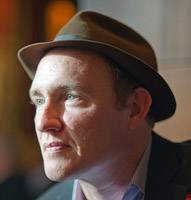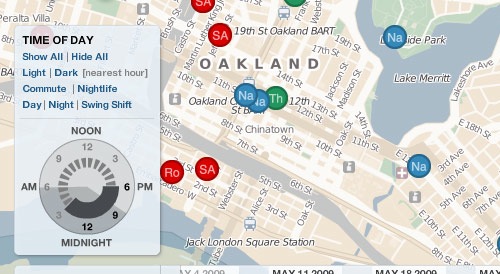The biggest winner in the 2010 Knight News Challenge, City Tracking, wants to give cities an open framework to tell their stories and for users to easily share and discuss them.
 Eric Rodenbeck, of the San Francisco design firm Stamen, wants to build data visualizations that are as compelling and user-friendly as photos or videos. “We want visualizations to be as easy to share and move around as a photo on Flickr,” Rodenbeck said. He hopes cities, journalists and locals will all use the end product.
Eric Rodenbeck, of the San Francisco design firm Stamen, wants to build data visualizations that are as compelling and user-friendly as photos or videos. “We want visualizations to be as easy to share and move around as a photo on Flickr,” Rodenbeck said. He hopes cities, journalists and locals will all use the end product.
Rodenbeck thinks there is both a great need for communities to better tell data-driven stories and a need for an open platform tool to tell them. He wants his tools to be “beautiful, interesting, and useful.” Google Maps is great, but it’s not in the public domain. “We’re finding that a lot of the tools that were out there are either really techy, or somebody else owns your data,” Rodenbeck told me. “We wanted to find that middle ground.”

To get an idea of the type of work that could come out of this new platform, take a look at Crimespotting. It’s a project Stamen started in Oakland that pulled public crime data into an interactive map. The city of San Francisco decided to create it’s own version. The tool lets users sign up for RSS feed updates and email alerts about their local communities. It also tells a bigger story about crime by plotting incidences on the map. It’s also nice looking and user friendly. “Tackling the kind of design aesthetic that a project like Crimespotting has, and extending it, is a huge part of it,” Rodenbeck told me in describing City Tracking.
Rodenbeck gave a more hypothetical example as well. An acquaintance of his wants to measure a local river’s temperature at various points, using input from other locals. Right now, there is no simple tool to power that project. It’s the kind of thing Rodenbeck would hope City Tracker would allow non-techies to do easily.
Like other Knight News Challenge winners this year, City Tracking is about presenting public information in a compelling, interactive format, rather than creating new news per se. At it’s core, the project is about engaging a community and getting residents thinking, talking and sharing. “I think we also want to encourage other kinds of conversations. Conversations about trees. Conversations about cabs. Conversations about pollution,” Rodenbeck said.
By that same token, Rodenbeck is eager for discussion while building the project. “What we don’t want to do is develop this in isolation. We want to announce it in small pieces. We’re really hoping to encourage the participation of other developers in the project. We don’t want to just be working away alone in our room, nerding away on our map projects.”